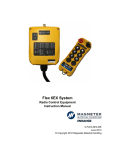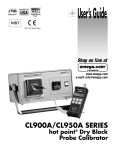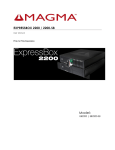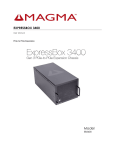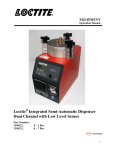Download Flex 8EX-T Master 2010
Transcript
FLEX8EX-T User’s Manual (Tandem System - Master) CE Version Table of Contents Page 1. Introduction 3 2. Radio Controlled Safety 4 3. General System Information A. B. Transmitter Handset 1. External Illustration (Tandem-Master Configuration) 5 2. Internal Illustration 6 Receiver Unit 1. External Illustration 7 2. Internal Illustration 8 4. I-Chip Programming 5. System Programming A. B. C. 9 Output Relay Configurations 1. Output Relay Types 10 2. Output Relay Action at 2nd Speed 10~11 3. ON/OFF Push Button Function 11 4. Magnet ON/OFF Push Button Function 12 5. Brake Function 12 6. External Warning Function 12 7. Momentary Contact 12 8. Toggled Contact 12 Dip-switch Settings 1. Interlocked Functions 13 2. Non-interlocked Functions 14 Jumpers Settings 15 Page 1 6. 7. D. I-CHIP Programming Port 16 E. Voltage Settings 16 Receiver Installation A. Output Relay Contact Diagram 17 B. Pre-Installation Precautions 18 C. Step-By-Step Installation 18~19 D. System Testing 19 Operating Procedure A. B. C. Transmitter Operation 1. General Operating Procedure 20~21 2. Tandem (master) Operation 22~23 3. 3rd Speed Push Button Operating Procedure 23 4. Changing Transmitter Batteries 23 Status Light Indicators & Warnings 1. Transmitter Status Light Indication 24 2. Receiver Status Light Indication 25 3. Receiver SQ Light Indication 25 4. Receiver POWER Light Indication 25 5. Receiver COM Light Indication 25 Trouble Shooting Tips 26 8. System Specifications 27 9. Spare Parts 28 Page 2 1. Introduction The FLEX radio remote control systems are designed for control of industrial equipment and machinery such as overhead traveling cranes, jib cranes, gantry cranes, tower cranes, electric hoists, winches, monorails, conveyor belts, mining equipment and other material handling equipment where wireless control is preferred. Each FLEX system consists of a transmitter handset and receiver unit. Other standard-equipped accessories include transmitter waist belt, spare transmitter power key, clear vinyl pouch, “AA” alkaline batteries, compass direction decal sheet and user’s manual. List of notable features include: * Over one million unique ID codes (20bit) – Each and every Flex system has its own unique ID codes and serial number, never repeats. * Advanced controls – The Flex system utilizes advanced microprocessor controls with 32bit CRC and Hamming Code, which provide ultra fast, safe, precise, and error-free encoding and decoding. * Unique I-CHIP design – The I-CHIP functions in a way that is very similar to SIM card used on mobile phones, with the ability to transfer system information and settings from one transmitter to another without the hassle of resetting the spares. * Reliable push buttons – The in-house designed push buttons with gold-plated contacts are rated for more than one million press cycles. * Low power consumption – Requires only two “AA” Alkaline batteries for more than 150 hours of operating time between replacements. * Ultra-durable nylon and fiberglass composite enclosures – Highly resistance to breakage and deformation even in the most abusive environments. * Full compliance – All systems are fully complied with the FCC Part-15 Rules, European Directives (Safety, EMC, R&TTE, Machinery) and Industry Canada Specifications (IC). Page 3 2. Radio Controlled Safety Flex radio remote control system should be operated by persons with sufficient amount of knowledge and skill in crane operation and safety. Persons being trained to operate a radio remote controlled crane should possess the knowledge of all hazards peculiar to radio remote controlled crane operation, ability to judge distance and moving objects, equipment capacity and radio remote controlled safety rules. Radio remote controlled cranes should not be operated by any person with insufficient eyesight, hearing, illness, and under influence of drugs and medications that may cause loss of crane control. Below are some general operating safety tips that should be strictly followed when operating a radio remote controlled crane. 1. Prior to crane operation always check the transmitter handset for any damage that might inhibit proper crane operation. 2. Always check if the red emergency stop button is working properly prior to crane operation. 3. Check the Status LED on the transmitter for any signs of low battery power (refer to page 24). 4. Check the Status LED on the transmitter for any signs of irregularities (refer to page 24). 5. The crane limit switches should be checked prior to crane operation or at the beginning of each shift. When checking limit switches the hoist should be centered over an area free of personnel and equipment. 6. If the power to the crane is removed, the operator should turn off the transmitter power immediately until the power to the crane is restored. 7. If the crane fails to respond properly to operator’s command the operator should stop operation, turn the transmitter power off, and then report the condition to their supervisor. 8. The transmitter power should be turned off after each use. If the transmitter handset is not in use always turn the power off and stored it in a safe or designated location. Never leave the transmitter handset unattended in the working area. 9. Make sure the system is not set to the same channel as any other Flex systems in use within a distance of 300 meters (900 feet). Page 4 3. General System Information A. TRANSMITTER HANDSET 1. External Illustration (Tandem-Master Configuration) (Fig. 01) (Fig. 02) 1. Emergency Stop Button 9. Push Button #5 2. Removable Power Key Switch 10. Push Button #7 (Pitch) 3. Push Button #2 11. Strap Ring 4. Push Button #4 12. System Information 5. Push Button #6 13. System Channel 6. Mechanical 3-stage A/B/A+B switch 14. Crane Number 7. Push Button #1 15. Battery Cover 8. Push Button #3 16. Approval Information Page 5 2. Internal Illustration (Fig. 03) (Fig. 04) 1. Encoder Board 6. I-CHIP 2. Arial Antenna 7. Function Dip-Switch 3. Transmitting Module 8. Channel Dip-Switch 4. Status LED Display 9. Battery Contact Mechanism 5. Function LED Displays Page 6 B. RECEIVER UNIT 1. External Illustration (Fig. 05) 1. Shock Mount 6. COM LED Display 2. External Antenna Jack 7. Output Contact Diagram 3. Power LED Display 8. System Information 4. Status LED Display 9. Cord Grip 5. SQ LED Display Page 7 2. Internal Illustration (Fig. 06) 1. AC Line Filter 4. Decoder Module 2. Power Transformer 5. Output Relay Board 3. Receiving Module Page 8 4. I-Chip Programming I-Chip functioned in a way that is very similar to a SIM card inside a mobile phone, which stores system information such as your phone number, account number, phone book and other settings. I-CHIP works exactly the same way, as it stores information such as system serial number/ID code, channel and push button configurations. When replacing a transmitter handset, just take the I-CHIP out of the old transmitter and install it into the new one (refer to Fig. 07 below). For complete information transfer, do make sure both the Channel and Function dip-switch is set to all “1”. If both dip-switches are set to all “1”, then the transmitter will operate according to the push button configurations and channel stored inside the I-CHIP. If both Channel and Function dip-switch is set to other values other than all “1”, then the transmitter will operate according to the channel and push button configurations set on these two dip-switches, not the ones stored inside the I-CHIP. Every time when the settings on these two dip-switches have changed, the new settings will be stored into the I-CHIP automatically. In this case the previous channel and push button configurations stored inside the I-CHIP will be erased and be replaced by the new settings. For safety purposes, system serial number/ID code stored inside the I-CHIP can not be changed directly on the transmitter encoder board. Only channels and push button configurations can be changed directly on the encoder board via Channel and Function dip-switches. There are only two ways that you can change transmitter serial number/ID code; 1) via I-CHIP programming port located on the decoder module inside the receiver unit, please refer to page 16 on how to program the I-CHIP (serial number/ID code) via receiver unit; 2) via an external I-CHIP programmer or duplicator unit available from the factory. Please ask your local dealers for assistance if your system requires serial number/ID code adjustments. (Fig. 07) Page 9 5. System Programming A. OUTPUT RELAY CONFIGURATIONS 1. Output Relay Types a. Three (3) output relays per motion – shared 2nd speed output relay Output relays with Forward 1st speed (F1), Reverse 1st speed (R1) and Forward/Reverse 2nd speed (F/R2). Forward and Reverse 2nd speed (F/R2) shared the same output relay. F1 b. R1 F/R2 Four (4) output relays per motion – separate 1st and 2nd speed output relays Output relays with Forward 1st speed (F1), Reverse 1st speed (R1), Forward 2nd speed (F2) and Reverse 2nd speed (R2). Forward and Reverse 2nd speed with separate output relays. F1 R1 F2 R2 2. Output Relay Actions at 2nd Speed a. 3-output relays configuration with Closed/Closed contact at 2nd speed At 2nd speed, both 1st speed (F1 or R1) and 2nd speed (F/R2) output relays are closed (refer to page 13 on how to set to this function). Forward 1st speed push button pressed Forward 2nd speed push button pressed ↓ F1 R1 ↓ F/R2 Page 10 F1 R1 F/R2 b. 4-output relays configuration with Opened/Closed contact at 2nd speed At 2nd speed, only the 2nd speed (F2 or R2) output relay is closed (refer to page 13 on how to set to this function). Forward 1st speed push button pressed Forward 2nd speed push button pressed ↓ F1 c. R1 ↓ F2 R2 F1 R1 F2 R2 4-output relays configuration with Closed/Closed contact at 2nd speed At 2nd speed, both 1st speed (F1 or R1) and 2nd speed (F2 or R2) output relays are closed (refer to page 13 on how to set to this function). Forward 1st speed push button pressed Forward 2nd speed push button pressed ↓ F1 R1 ↓ F2 R2 F1 R1 F2 R2 3. ON/OFF Push Button Function The user can set any of the two adjacent push buttons on the transmitter to behave like a mechanical ON & OFF rocker switch (refer to page 13 on how to set to this function). When “On” output relay is closed (“On” push button pressed), the “Off” output relay will open automatically, or vise versa. OFF Page 11 ON 4. Magnet ON/OFF Push Button Function The user can set any of the two adjacent push buttons on the transmitter to control a magnet. To activate the magnet just press the push button with the Magnet symbol. To deactivate the magnet, for safety purpose, you must first press and hold the Magnet push button and then press the OFF push button. Press the OFF push button by itself can not deactivate the magnet (refer to page 13 on how to set to this function). OFF 5. Brake Function When the transmitter push button is released from 2nd speed up to 1st speed, both 1st and 2nd speed output relays will open for up to 1.0 second and then with 1st speed output relay closed thereafter (refer to page 13 on how to set to this function). 6. External Warning Function The user can install an external warning device (rotating lights, horn, etc…) to a special “Function output relay” located inside the receiver. The user can choose which push button pairs or crane motions he desired to have external warnings when push button is pressed (refer to page 13 on how to set to this function). 7. Momentary Contact When push button is released the output relay corresponds to that push button will open (refer to page 14 on how to set to this function). This type of contact is usually applies to external application such as horns or buzzers. 8. Toggled Contact When push button is released the output relay corresponds to that push button will remained closed (maintained contact) until next time the user presses the same push button again (refer to page 14 on how to set to this function). This type of contact is usually applies to external application such as lights. 9. 3rd Speed Push Button Function This function allows the crane to travel an additional step beyond 2nd speed. For example, if the operator is pressing the “UP” push button down to 2nd speed, pressing the 3rd speed push button (with “UP” push button still hold at 2nd speed) will toggle between 2nd speed and 3rd speed (refer to page 14 on how to set to this function). 3rd SPEED Page 12 B. DIP-SWITCH SETTINGS 1. Interlocked Functions Interlocked means the two adjacent push buttons can not be activated simultaneously at the same time as it will cancel each other out. Interlocked settings are usually applied to crane’s forward and reverse motions. Each dip-switch on the decoder module corresponds to one (1) motion or two (2) adjacent push buttons (refer to Fig. 08 & 09 below). Only the first 7 dip-switch positions are used (counting from left to right), the 8th dip-switch position (far right) is not used. (Fig. 08) 1 2 3 4 5 6 7 8 RELAY FUNCTIONS (Fig. 09) ▇ Manufacture preset Dip Settings Function Descriptions # of Relays Used 0000000 Normal (single speed only, F2 & R2 relays not used) 2 0000001 nd 4 nd Closed/Closed Relay Action at 2 Speed (separate 2 speed relay) nd nd 0000010 Closed/Closed Relay Action at 2 Speed (shared 2 speed relay) 3 0000011 Opened/Closed Relay Action at 2nd Speed (separate 2nd speed relay) 4 0000110 On (right button) & Off (left button) 2 0001001 On + Start / Off + Start -- Prior to pressing the button you must first rotate and hold the power key switch at START position to activate On or Off relays. 2 0000111 Safety Magnet On & Off 2 0010000 Normal + External Warning* 2 0010001 Closed/Closed Relay Action + External Warning* 4 0010010 Closed / Closed Relay Action + External Warning* 3 0010011 Opened/Closed Relay Action + External Warning* 4 0100001 Closed/Closed + Brake 4 0100010 Closed/Closed Relay Action + Brake 3 0100011 Opened/Closed Relay Action + Brake 4 0110001 Closed/Closed Relay Action + Brake + External Warning* 4 0110010 Closed/Closed Relay Action + Brake + External Warning* 3 0110011 Opened/Closed Relay Action + Brake + External Warning* 4 * External warning function requires installing an external warning device such as horn and rotating lights to the function relay output. Page 13 2. Non-interlocked Functions Contrary to interlocked settings, non-interlocked settings allow the two adjacent push buttons be used simultaneously at the same time. Non-interlocked settings are usually applied to crane’s auxiliary functions such as lights, horn and 3rd speed. Each dip-switch on the decoder module corresponds to one (1) motion or two (2) adjacent push buttons (left & right push buttons). Dip Dip Position Setting Function Position #2 ~ #4 (left button) Code Setting & #1 #5 ~ #7 (right button) A 1 000 Normal (momentary) contact. B 1 001 Toggled (latching) contact. C 1 010 Acceleration (3rd speed). 100 Normal + Start function. For added safety, you must first rotate and hold the power key switch at “START” position and then press the intended push button at the same time to activate the output relay. D 1 Function Description Example #1: Left button (set to function code A) / right button (set to function code A) → 1 000 000 Example #2: Left button (set to function code B) / right button (set to function code B) → 1 001 001 Example #3: Left button (set to function code A) / right button (set to function code C) → 1 000 010 Example #4: Left button (set to function code C) / right button (set to function code D) → 1 010 100 Page 14 C. JUMPER SETTINGS The jumpers #6 & #7 is located on the decoder module above the four (4) dip-switches (refer to Fig.10 below). For Tandem systems only JP6 & JP7 is applicable, JP1~JP5 are unused. (Fig. 10) Jumper Settings Function JP6 (Blank) Program system serial number/ID code and channel from decoder module to I-CHIP. JP6 (Inserted) Program system serial number/ID code and channel from I-CHIP to decoder module. JP7 (Inserted) For system test only, receiver MAIN disabled. Page 15 JP7 JP6 JP5 JP4 JP3 JP2 JP1 ▇ Manufacture preset D. I-CHIP PROGRAMMING PORT (Fig. 11) I-CHIP programming port located on the decoder module (refer to Fig. 11 above) inside the receiver is designed for the purpose of transferring system serial number/ID code either from I-CHIP to receiver or from receiver to I-CHIP. If you wish to transfer system information from receiver to I-CHIP, just insert the I-CHIP onto the programming port (JP6 jumper not inserted), wait until the Status LED on the decoder module turned constant green (within 2 seconds), and then take the I-CHIP out of the programming port (programming completed). At this time the I-CHIP should also possess the same serial number/ID code as the receiver. If the Status LED on the decoder module displayed a constant red light after inserting the I-CHIP (programming failed), then you must reinsert the I-CHIP one more time. On the other hand, if you wish to transfer system information from I-CHIP to receiver, then you must first insert JP6 jumper prior to inserting the I-CHIP, then wait for the green light to appear on the Status LED. At this time the receiver should also possess the same system information as the I-CHIP. Please note that the receiver unit must be powered in order to proceed with the programming. E. VOLTAGE SETTINGS Prior to installation always check the voltage setting is correct for your application (refer to Fig. 12 below). Position 1 → 110~120VAC Position 2 → 220~240VAC or 24VAC* Position 3 → 380~400VAC or 42VAC* Position 4 → 410~460VAC or 48VAC* or 12~24VDC** * For system with 24/42/48VAC power supply. ** For system with 12~24VDC power supply. COM 1 2 3 4 (Fig. 12) F9 and F10 power fuse ratings: FUSE # 110~120VAC 220~240VAC 380~400VAC 410~460VAC 24VAC 42 & 48VAC 12~24VDC F9 1.0A (red) 1.0A (red) 1.0A (red) 0.5A (blue) 3.0A (yellow) 2.0A (purple) 2.0A (purple) F10 1.0A (red) 1.0A (red) 1.0A (red) 0.5A (blue) 3.0A (yellow) 2.0A (purple) 2.0A (purple) * Output relay fuse → 5.0A (clear) Page 16 6. Receiver Installation A. OUTPUT RELAY CONTACT DIAGRAM Note A: For 3-relay (shared 2nd speed) and 4-relay (separate 2nd speed) configuration please refer to page 10~13. Note B: For 4-relay closed/closed and 4-relay opened/closed relay configuration please refer to page 10~13. Note C: For different voltage settings please refer to page 16. Note D: For F9 and F10 power fuse ratings please refer to page 16. Note E: For 12~24VDC power supply, wire #1 corresponds to the negative charge (-) and wire #3 corresponds to the positive charge (+), wire #2 is for GROUND. Page 17 B. PRE-INSTALLATION PRECAUTIONS 1. Make sure the transmitter and receiver are with identical serial number/ID code and channel. 2. Make sure the receiver is not set to the same channel as any other systems in use in the surrounding area. 3. Make sure that the crane or equipment is working properly prior to installation. 4. Make sure the power source to the receiver is set correctly. 5. Switch off the main power source to the crane or equipment prior to installation. C. STEP-BY-STEP INSTALLATION (Fig. 13) Page 18 1. For best reception the location of the receiver should be visible to the operator at all time. 2. The location selected should not be exposed to high levels of electric noise. Mounting the receiver next to an unshielded variable frequency drive may cause minor interference. Always locate the receiver as far away from variable frequency drive as possible. 3. Ensure the selected location has adequate space to accommodate the receiver (refer to Fig. 13 on page 18). If an external antenna is used, to avoid the possibility of antenna damage always locate the receiver where the antenna is 432 mm free from any obstacles from all directions (refer to diagram at right). 4. When installing an external antenna you must connect the SMA jack located Control Panel inside the receiver and make sure to set the jumper to “EXT” position (refer to diagram below). 5. For better reception, make sure the receiver is in an upright position. 6. Drill two holes (10mm in diameter) on the control panel or location where the receiver is to be installed (refer to Fig. 13 on page 18). 7 Make sure the two bolts are tightened after installation. 8. For system wiring please refer to page 17. D. SYSTEM TESTING 1. Turn on the power source to the receiver and test the MAIN relay output by pressing the red emergency stop button and observe that it properly opens and closes the mainline disconnect contactor. 2. Test the operation of each function to ensure it corresponds to the transmitter direction labels or the pendent it is replacing. 3. Test the limit switches (if any) to see if they are working properly. 4. If your new remote control is replacing an existing pendant, make sure it is completely disconnected and placed in a safe location to prevent unwanted control command. Page 19 7. Operating Procedure A. TRANSMITTER OPERATION 1. General Operating Procedure a. Reset the red emergency stop button located on the top left hand side of the transmitter handset by rotating it either clockwise or counter clockwise, the red button will pop up. b. Turn on the transmitter power by inserting the black-colored key into the power key slot located on the top right hand side of the transmitter handset and rotate it clockwise to “On” position. c. After turning on the transmitter power, check the Status LED on the transmitter handset for any sign of system irregularities (refer to “Status Light Indicators & Warnings” on page 24). If the system is normal the Status LED will light up green for two (2) seconds. d. If there are no signs of any system irregularities, then rotate the power key-switch further to CATCH position for up to 2.0 seconds to activate all transmitter push button functions and as well as the receiver MAIN. Then press any push button on the transmitter to begin operation. Pressing any push button prior to initiating the CATCH command will result in no signal transmitted (blinking orange light). Page 20 e. In case of an emergency, press down the red emergency stop button will immediately disconnect the receiver MAIN and as well as the transmitter power. To resume operation, rotate the red button clockwise or counter-clockwise, it will pop up. Then rotate the power key-switch to CATCH position for up to 2.0 seconds to activate all transmitter push button functions and the receiver MAIN. Please note that every time when you turn the transmitter power off and back on again or after resetting the emergency stop button, all push button functions will be locked to avoid any unintentional controls. For safety, initiating the CATCH command after turning on the transmitter power or after resetting the emergency stop button is strictly required. f. After 5minutes of inactivity (push button not pressed) the receiver MAIN will be disconnected temporarily. To resume operation, you must rotate the power key-switch on the transmitter to CATCH position prior to initiating any motion commands. The receiver MAIN will also be disconnected temporarily when the receiver encounters strong radio interference or when the operator is controlling the crane or equipment beyond the transmitting range. g. Turn off the transmitter power by rotating the power key counter-clockwise to “Off” position; it will disconnect the transmitter power and the receiver MAIN altogether. Turn it further counter-clockwise to release the key. Page 21 2. Tandem (master) Operation This system is capable of operating one or two cranes independently or simultaneously at the Receiver A Receiver B Master Transmitter Slave Transmitter same time (Crane A, B, A+B operation). Please follow the instruction below for safe operation. a. To gain control of one or both receivers, first rotate the selector switch to either A, B or A+B position and then rotate the power key switch to CATCH position for up to 2.0 seconds. But please keep in mind that in order to gain control of receiver B, PITCH push button on the slave transmitter must be initiated prior to your takeover. For example, in order for master transmitter (your transmitter) to also take over receiver-B, slave transmitter must first release its control of receiver-B by pressing the PITCH push button for up to 2.0 seconds. This action will release control of slave transmitter to receiver-B. Thereafter, master transmitter is able to take control of receiver-B by first rotate the selector switch to B position and then rotate the power key to CATCH position for up to 2.0 seconds. Make sure that the CATCH command is executed 2.0 seconds after salve transmitter initiates the PITCH command (refer to diagram below). Press PITCH Rotate to B position → Rotate to CATCH → (After 2 seconds) Slave transmitter b. Master transmitter Master transmitter Once the transmitter is locked on to both receivers, then rotate the selector switch to either A, B, or A+B position for independent or simultaneous operation. Page 22 c. At beginning of each shift prior to turning on the transmitter power, always check if the selector switch is correctly positioned for the intended receiver or receivers. d. For safety reason, there is a 2-second grace period followed after initiating the PITCH command. What this means is that when PITCH push button is pressed or initiated, rotating the power key switch to CATCH position on the other transmitter within this 2-second grace period is ineffective. In order to gain control of the other receiver you must first wait for up to 2 seconds after the other transmitter presses the PITCH push button and then execute the CATCH command. 3. 3rd Speed Push Button Operating Procedure When a push button is hold at 2nd speed, pressing the 3rd Speed push button one time will activate the 3rd speed output relay (toggled). If the operator wants 2nd speed again, just press the 3rd Speed push button one more time. Please refer to page 14 on how to set 3rd Speed function. 3rd SPEED 4. Changing Transmitter Batteries Changing transmitter batteries by unscrewing the battery cover located on the backside of the transmitter. During battery installations make sure that the blue ribbon is centered between the two batteries. After changing the batteries also make sure that all screws are tightened to avoid water, moisture, dirt, grease, or other liquid penetration. 2 1 ↓ Page 23 B. STATUS LIGHT INDICATORS & WARNINGS 1. Transmitter STATUS Light Indication Type Display Type Indication Voltage below 1.9V at initial power on, 1 transmitter power and receiver MAIN shuts off. Constant red Voltage below 1.8V during operation, transmitter power and receiver MAIN shuts off. 2 3 1 red blinks followed by a 2-second Voltage below 1.85V during operation, warning, pause change batteries suggested. 2 red blinks followed by a 2-second The pushbutton is defective after turning on the pause transmitter power. When defective push button condition occurs (2 red blinks, type 3 above), find out which push button is defective by pressing all the push 4 buttons on the transmitter one at a time. If the No light displayed push button is in good working order, the LED will not light up when pressed. If the push button is defective the LED will continue to display 2 red blinks when pressed. 5 3 red blinks followed by a 2-second pause EEPROM error. 4 red blinks followed by a 2-second Transmitting error, system can not locked on pause to the designated channel. 7 Constant green for up to 2 seconds Transmitter power on with no faults detected 8 Blinking green Transmission in progress. 9 Blinking orange Transmitter push button functions locked. 6 Page 24 2. Receiver STATUS Light Indication Type Display Type (Green & Red) Indication 1 Fast green blinks Decoding in process 2 Slow green blinks Decoding on standby 3 Two red blinks Receiver MAIN jammed or defective 4 Fast red blinks Incorrect transmitter serial number/ID code 5 Constant red Receiver under-voltage, LV output relay activated 3. Receiver SQ Light Indication Type Display Type (Red) Indication 1 Fast blinks Transmission received 2 Completely off No transmission 3 Blinks intermittently Other radio interference 4. Receiver POWER Light Indication Type Display Type (Red) Indication 1 On Power to receiver 2 Off No power to receiver 5. Receiver COM Light Indication Type Display Type (Red) Indication 1 On Power to relay Board 2 Off No power to relay board Page 25 C. TROUBLE SHOOTING TIPS Problems Possible Reasons Suggestions Transmitter low battery power Check the transmitter battery level. Emergency stop button activated prior to startup No responds when transmitter push button is pressed Improper startup procedure Prior to turning on the transmitter power switch make sure that the red emergency stop button is elevated. Redo the startup procedure. Check and make sure that the transmitter Incorrect system RF channel handset and receiver unit both have the same channel. (Improper startup & settings) Incorrect system serial number/ID code Check and make sure that the transmitter handset and receiver unit both have the same serial number/ID code. Make sure that the startup procedure is System out of range initiated within 100 meters (300 feet) from the receiver location. Check the SQ display on the face of the receiver unit. If it does not light up when push button is pressed then either No responds when transmitter push button is pressed Defective transmitting and the transmitting or receiving module is receiving module defective. First replace the transmitting module. If SQ display still not lid when push button is pressed then go ahead and replace the receiving module. (Damaged hardware) If still no responds, then replace the Defective encoder transmitter encoder board. If still board or decoder module doesn’t work then the decoder module is defective. Incorrect input voltage No AC power to the receiver Outputs do not correspond to transmitter Make sure the source voltage is set correctly. Blown fuse Check for any blown fuse. Incorrect wiring Check input voltage connection. Check the system wiring again. Please Incorrect output connection refer to the output contact diagram inside this manual or on the receiver cover. Page 26 8. System Specifications Frequency Range : 433 ~ 434 MHz Number of Channels : 62 channels (Standard) / 2 channels (Tandem) 3 channels (Random Access) Channel Spacing : 25 KHz Modulation : Digital Frequency Modulation based on Manchester Code, 20bit address, 32bit CRC Parity Check and Hamming Code. Encoder & Decoder : Microprocessor-controlled Transmitting Range : >100 Meters / 300 Feet Hamming Distance : >6 Frequency Control : Synthesized PLL (Phase Lock Loop) Receiver Type : Frequency Auto Scanning Receiver Sensitivity : -116Bm Spurious Emission : -50dB Antenna Impedance : 50 ohms Responding Time : 40 Milliseconds (average) Transmitting Power : 1.0mW Enclosure Type : NEMA-4X Enclosure Rating : IP-66 Output Contact Rating : 250V @ 10 Amps Transmitter Operating Voltage : DC 3.0V Receiver Power Consumption : 11.0 VA Operating Temperature : -25℃ ~ 75℃ / -13℉ ~ 167℉ Transmitter Dimension : 184mm (L) x 69mm (W) x 34mm (H) Receiver Dimension : 363mm (L) x 228mm (W) x 70mm (H) Transmitter Weight : 242g / 8.5oz Receiver Weight : 2.5kg / 5.5lb Page 27 9. Spare Parts 1. Transmitting Module (433/434MHz) TRB 01 2. Encoder Board (complete with push buttons) ENB 08 3. I-CHIP (complete) ICP 01 4. Receiving Module RVB 01 5. Decoder Module DEB 04N 6. Receiver Relay Board RLB 05N 7. AC Line Filter Board LFB 01 8. Power Transformer AC 110~120V/220~240V/380~400V/410~460V PTF 01 AC 24V/42V/48V PTF 02 DC 12V~24V PTF 03 9. Transmitter Top Casing TTC 06N 10. Transmitter Bottom Casing TBC 02 11. Transmitter Battery Cover TBC 04 12. Receiver Top Casing RTC 01 13. Receiver Bottom Casing RBC 01 14. Cord Grip CGR 01 15. Shock Mount SMT 01 16. 2-Step Push Button PBN 02 17. 3-Stage Mechanical Selector Switch SWT 01 18. Push Button Rubber Boot PRB 01 19. Emergency Stop Button EMS 01N 20. Transmitter Power Keys Switch PWK 01 21. Waist Belt WBT 01 22. Strap Ring STR 01 23. Safety MAIN relay SMR 01 24. Regular Output Relay RLY 01 25. Clear Vinyl Pouch CVP 04 26. External Receiver Antenna ANT 01 Page 28






























